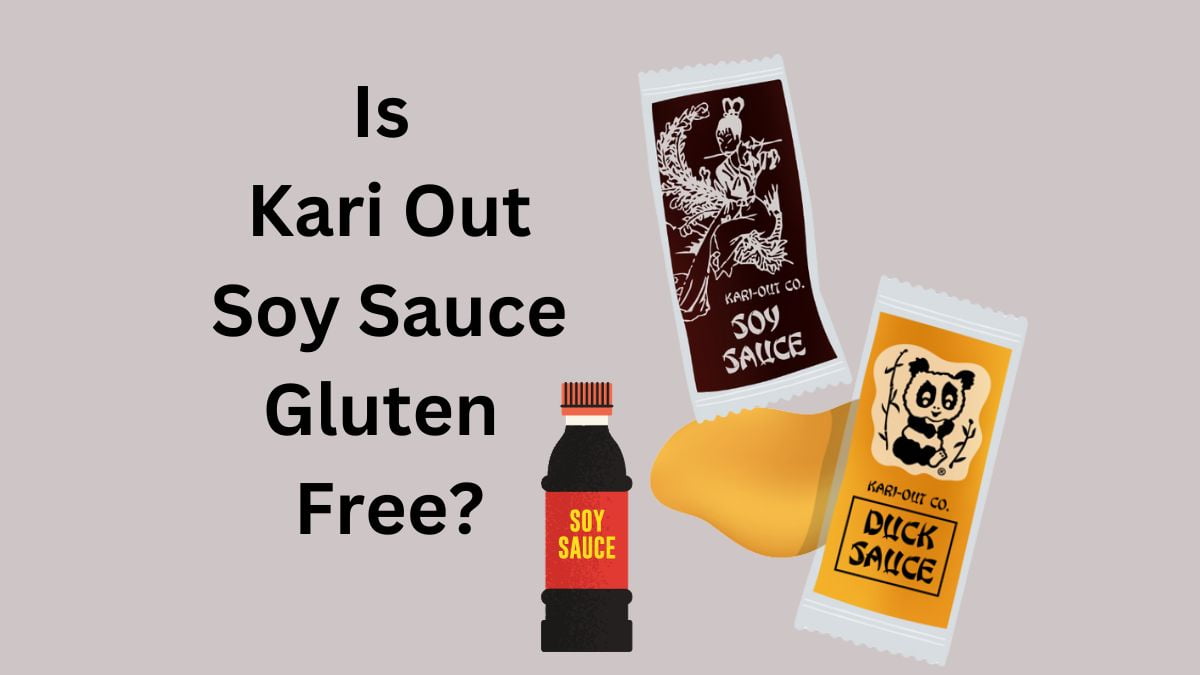People who have chosen to live a gluten-free diet or who suffer from celiac disease and gluten sensitivity frequently ask themselves Is kari out sot sauce gluten-free or not? Knowing how gluten-free this popular condiment is crucial in a world where food options may be as varied as the cuisines we enjoy.
Picture a hot bowl of stir-fried noodles that is oozing with soy sauce’s rich, delicious flavor. It’s a culinary treat for many. But for people navigating the tricky world of dietary restrictions, an innocent-looking item can turn a delicious dish into something to be wary of.
We set out on a quest to learn the real story behind the gluten content of Kari Out Soy Sauce in this blog article. We’ll explore the complexities of gluten, its effects on health, and the significance of gluten-free labeling in addition to the label and the delicious umami flavor it adds to food. This page intends to be your reliable guide, offering advice, alternatives, and professional opinions—whether you’re a seasoned gluten-free expert or just starting out on this journey.
Come along as we discuss the larger picture of living a gluten-free lifestyle in addition to answering the topic, “Is Kari Out Soy Sauce Gluten Free?” For the benefit of your health and culinary explorations, you should feel clear and confident in your decisions. Now, let’s go off on this delectable adventure where peace of mind and dietary preferences collide with understanding.
What Is Kari Out Soy Sauce
Kari-Out is a brand of gluten-free soy sauce substitute produced by La Choy and ConAgra Foods. It was created to provide the flavor of regular soy sauce to those who must avoid gluten due to medical conditions like celiac disease.
Soy sauce often referred to as “liquid gold” has its roots in ancient China. It’s a condiment with a history that spans over 2500 years. This Dark, savory elixir is made from soybeans, wheat, salt, and water. But what makes kari out soy sauce unique?
Using soybeans as its foundation, water, salt, and corn syrup, Kari-Out employs a classic fermented brewing method without the use of wheat or barley. With no gluten, the finished product has a flavor similar to that of salty-umami soy sauce.
Less than 20 ppm (parts per million) of detectable gluten is present in Kari-Out soy sauce, according to the manufacturer. As a point of reference, FDA rules state that products labeled as gluten-free must have fewer than 20 ppm. Keeping levels this low gives those who are sensitive and react even to tiny amounts of troublesome protein confidence.
How Kari-Out Achieves Gluten-Free Status
The ingredients and manufacturing method are crucial to Kari-Out’s gluten-free claims, as was previously indicated.
Soybeans and wheat are combined to make the majority of conventional soy sauces. Wheat supplies the carbohydrates required for fermentation and contributes to the thickness and gloss of soy sauce. It is therefore inappropriate for people who are avoiding gluten.
Kari-Out is naturally gluten-free because it is made entirely of soybeans and no wheat. Without the use of wheat or barley, the fermentation process depends on microorganisms to break down the proteins and carbs in the soybeans alone.
During manufacture, corn syrup is added to provide sweetness to counterbalance the saltiness and to replicate the viscosity of soy sauce brewed with wheat. Natural caramel coloring completes the visual appeal.
La Choy uses a number of quality control procedures to reduce the possibility of cross-contamination. Kari-Out is manufactured using distinct machinery from other goods. The facilities adhere to stringent sanitation protocols and allergen control policies. To make sure there are no traces of gluten-containing cereals, tests are also performed on raw materials.
La Choy is able to meet the <20 ppm gluten criteria and obtain gluten-free certification from multiple reliable organizations thanks to these manufacturing practices:
- Celiac Support Association (CSA)
- Celiac Sprue Association (CSA)
- Gluten Intolerance Group
The additional reassurance that strict procedures are followed to create genuine gluten-free soy sauce comes from this third-party authentication.
Taste and Uses of Kari-Out Soy Sauce
Although tastes and flavors vary greatly, many reviews claim that Kari-Out has a less salty, darker, and sweeter flavor profile than regular soy sauce. The molasses-like tone is a result of the corn syrup influence. Though not as strong, the umami is still discernible.
Regarding how well it substitutes real soy sauce, opinions appear to differ. While some consider it to be a satisfying replacement, others view it as a whole other animal. It all boils down to personal preference for flavor.
Delivering the essence of soy sauce without using wheat or gluten is where Kari-Out really shines. It can enhance the color and flavor profile of:
- Sauces and marinades
- Fried rice dishes with stir-fries
- Rolls of sushi
- Meats such as beef, fish, and fowl
- Veggies, such as broccoli and green beans
- Enhances the flavor of rice or Asian noodles when cooked.
The applications are as varied as normal soy sauce. In order to achieve the ideal flavor balance while minimizing the impact of corn syrup, chefs will need to modify their recipes and do tasting tests.
Kari-Out Labeled Gluten-Free – But Buyer Beware
Kari-Out makes it obvious on labeling and promotional materials that it is a gluten-free alternative to conventional soy sauce. Based on the information at hand, it appears that this marketing is warranted given the strict production procedures and third-party certifications that are in place.
Celiac disease sufferers are aware that no matter how carefully a product is packaged, it will never be completely gluten-free. Cross-contamination is a constant issue in supply chains and production processes. Where to draw the line and how comfortable you are are decisions that only you can make.
Being an educated consumer is the best course of action. Use their codes to verify Kari-Out’s testing certificates for each batch, and get in touch with customer support if you have any problems. Before using liberally, start with modest doses to see if you react. And be aware that Kari-Out is not your only option if you wind up reacting—there are plenty of excellent gluten-free soy sauce substitutes available right now.
The Final Words
Kari-Out wants to give the underserved gluten-free market the appearance, flavor, and functionality of soy sauce. By all accounts, La Choy has produced a product that is safe for celiac diets because it doesn’t use wheat or barley during production and adheres to rigorous gluten-free guidelines. Personal sensitivities vary, though. Assessing your personal tolerance in light of ingredients, production processes, and personal reactions will help you decide whether Kari-Out soy sauce belongs in your gluten-free kitchen or if there are better solutions available. In either case, the gluten-free population benefits from having more options.



